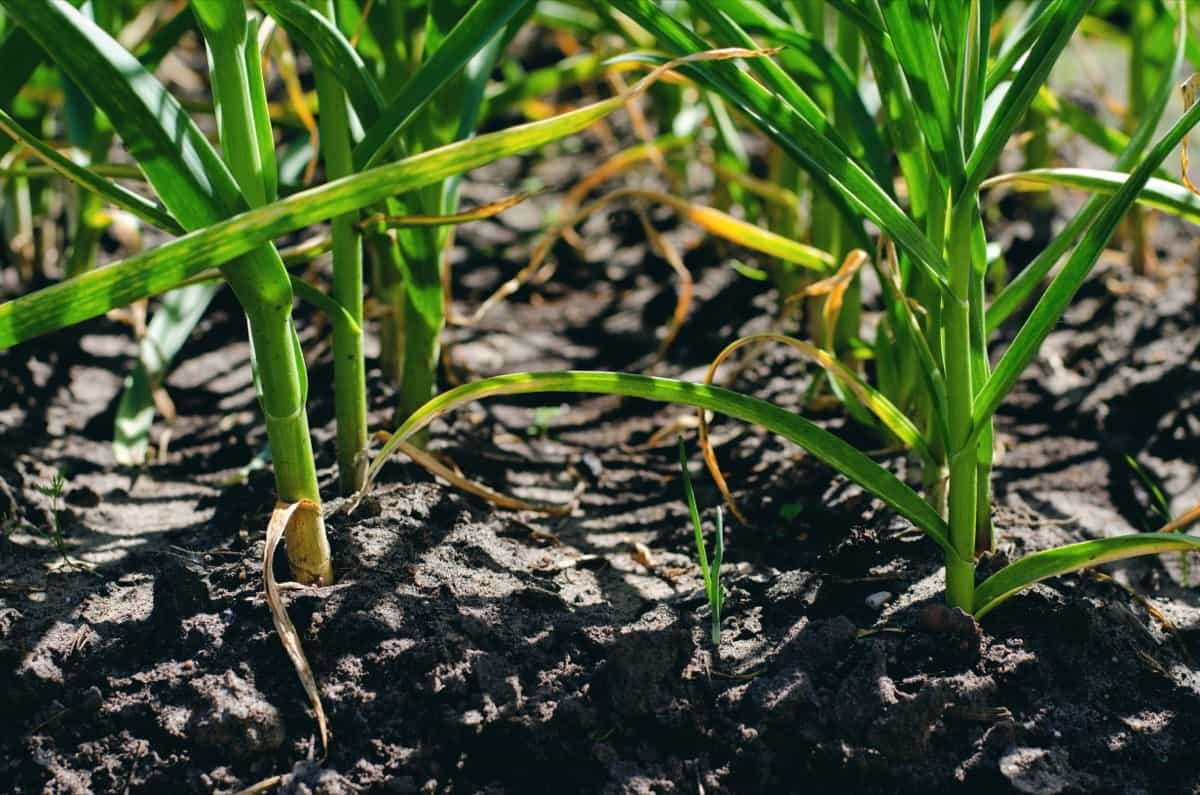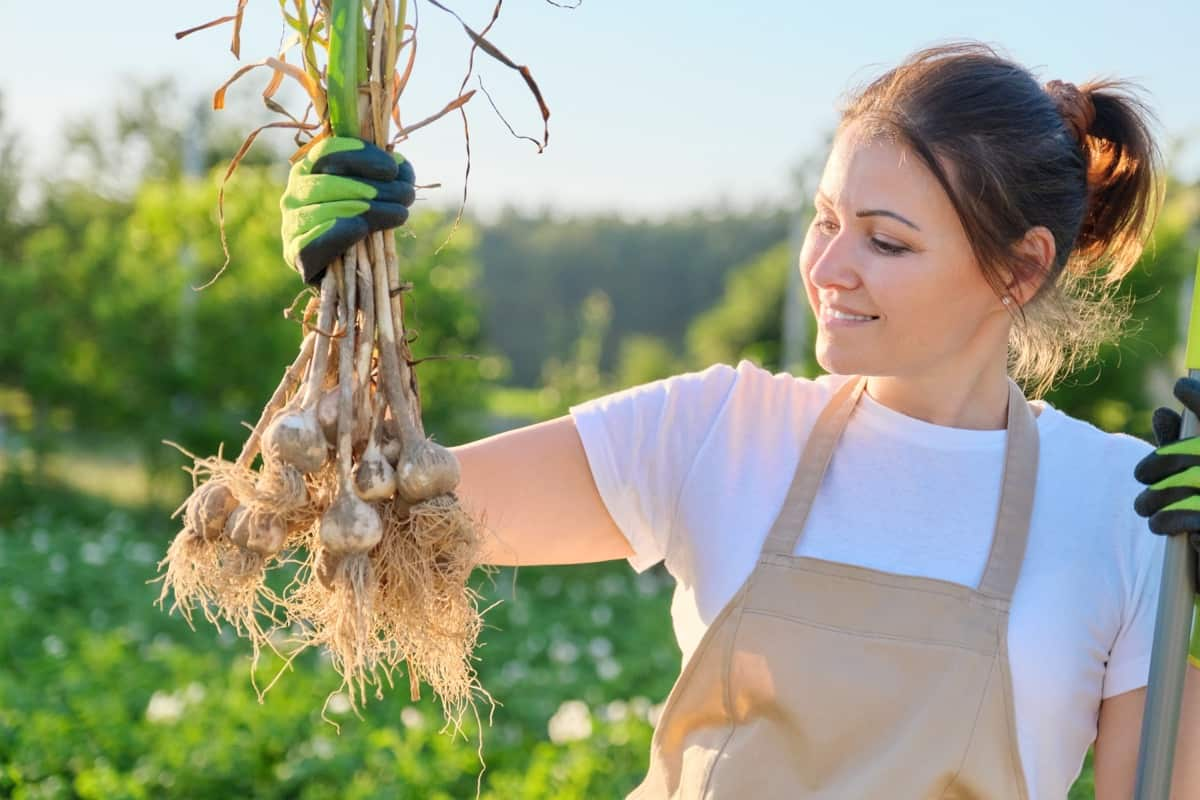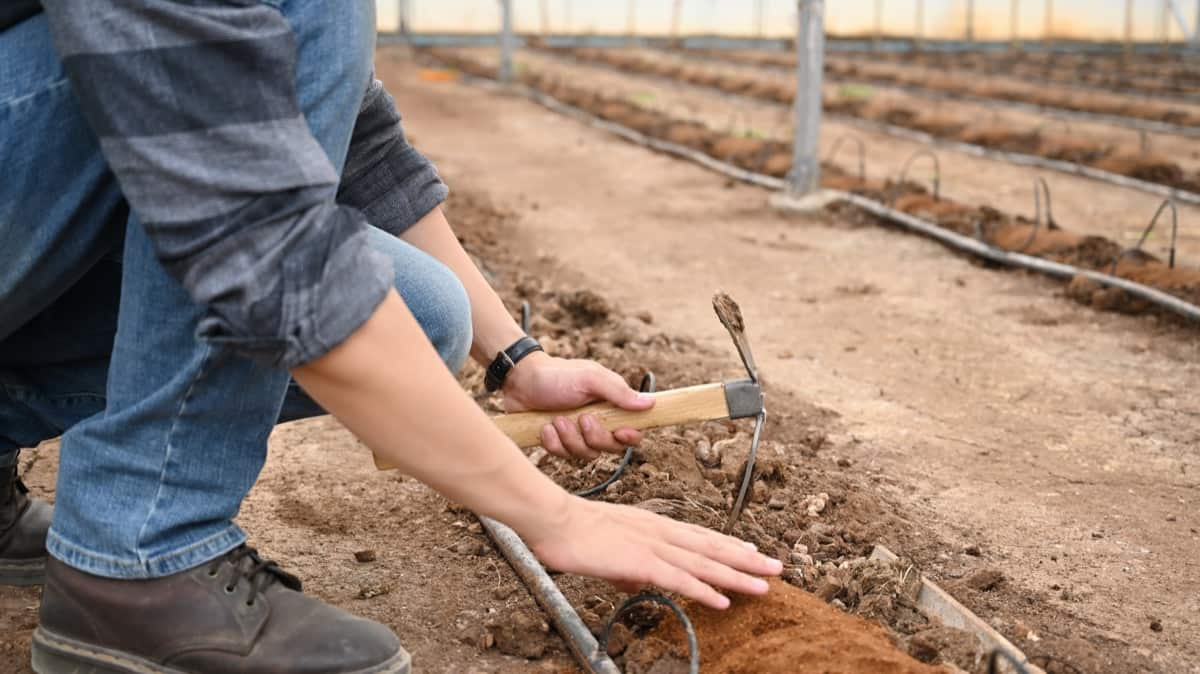Garlic can be grown in greenhouses with less hassle than outside. Controlling the climate is key to ensuring a consistent harvest regardless of weather conditions. As a result, the winter variety is protected against freezing or early germination. Planting the spring variety 1-2 weeks earlier is possible because it is tolerant of spring frosts. Greenhouses prevent garlic from rotting and allow it to ripen faster. You will reap a rich harvest if you properly care for your crops.

How to Grow Garlic in Greenhouse
Garlic Varieties Suitable for Greenhouse Cultivation
- Gafurian: Non-darting, belongs to medium early varieties. The period from full germination to technical ripeness is 83 to 90 days. The head weight is 12 to 34 grams, and the number of cloves is 16-18. The structure is complex, and the pulp is dense.
- Komsomolets. A high-yielding species with a growing season of 120 days. Bulb weight is up to 30 grams. It has from 6 to 13 cloves. It has good resistance to low temperatures.
- Boguslavsky: The growing season from the mass regrowth of cloves to the lodging of leaves is 87 to 98 days. It is a high-yielding variety with a bulb weight of 45 grams. It has six cloves.
- Alcor: Ripens in a greenhouse for 87 to 98 days. The mid-season shooting variety consists of 4 to 5 cloves. It has a head weight of 13 to 36 grams.
How to Plant Garlic in Greenhouse
Seed garlic should only be purchased from a nursery or seed company that sells fresh seed garlic. A fungicide or other chemical is usually applied to grocery store garlic to prevent sprouting. You will get better results if you purchase garlic seeds from a reputable, certified disease-free source. Buying seeds from a nursery or catalog will also give you more variety. Before planting, you should remove any weeds, then dig in organic matter to improve the soil’s structure, moisture retention, and nutrient levels.
Approximately two buckets of well-rotted manure or compost should be applied per square meter. Fresh manure should not be used. The amount of fertilizer needed at planting is minimal. Generally, 25 grams of general-purpose fertilizer per square meter should be applied to the soil. The amount of fertilizer should be doubled where organic matter has not been applied. The soil can be covered with black plastic sheeting or a weed-defeating membrane, and then cloves can be planted through slits.
Whole garlic bulbs are sold as garlic seeds. A new bulb will be produced from each clove. Take your bulb and separate the cloves when you get them. Each clove should be kept in its papery husk. Each clove should be planted 2 inches deep and 2 to 4 inches apart, with the wide roots facing down and the pointed ends facing up. A row should be spaced 10 to 14 inches apart and then watered and mulched. During the winter, garlic will need to be protected by a thick layer of mulch if you live in a cold climate.
In case you missed it: 1 Acre Green Gram Cultivation Project Report in India: Production Cost and Profit

How to Grow Garlic in Greenhouse
After the threat of frost has passed, remove the mulch in the spring. You can feed your garlic by side-dressing, adding nitrogen-rich fertilizer to the stems. The bulbs will begin to swell as summer approaches. Feed them again as they begin to swell.
Whenever flower shoots (scapes) appear, remove them. The size of the bulb will decrease as a result of flower shoots. Ensure your garlic patch is weed-free during this time, and provide them with 1 inch of water each week. Decrease watering about two weeks before harvest time (depending on your climate and the variety you planted).
Soil Requirements to Grow Garlic in Greenhouse
It prefers soil temperatures between 4.5°C and 10°C. Garlic can grow in your greenhouse year-round if you have a heat source. Because garlic is a root crop, it prefers rich, luscious soil or silty topsoil with a pH between 6.5 and 7.0. You can do a soil test if you are unsure about your soil’s pH. Using it, you can determine which nutrients your soil contains before planting.
Sunlight and Temperature to Grow Garlic in Greenhouse
The cloves of garlic love the sun. Therefore, they should be provided daily sunlight for at least six hours. If unsure, you can supplement their light with LED grow lights. Ensure the temperature doesn’t get too hot; otherwise, the cloves won’t grow. It is important to maintain temperatures between 15.5-27°C but not exceeding 32 °C.
Fertilizer Requirements to Grow Garlic in Greenhouse
Once growth begins in spring, fertilize every 30 days until the end of May. An all-purpose fertilizer with an NPK ratio of 5-5-5 or 10-10-10 is recommended. This is the ratio of nitrogen to phosphorus to potassium, and the main macronutrient plants need to grow. Apply granular fertilizer as a side dressing, or broadcast it over the bed. It is important not to overfertilize, as this may result in too much top growth and underdeveloped bulbs.
Watering Requirements to Grow Garlic in Greenhouse
Watering is the next and most important part of growing any plant. Check the soil’s moisture to ensure you are not overwatering or underwatering your garlic plant. A gentle flow of water should be applied to the soil until it is completely moist without a layer of water on top. Adding water until you see water coming from the bottom of the pot or container is another way to ensure proper watering. Your soil must be semipermeable so that water can easily flow through it.
During bulb growth, water will be gradually reduced. When harvesting garlic bulbs, stop watering when the leaves dry and fall down. It has usually done a week or two before you harvest the bulbs. Watering should be stopped at that time to avoid staining the bulb skin and prevent disease spread. Garlic’s flavor is also improved when it is not watered.
In case you missed it: How to Grow Microgreens in Greenhouse: A Step-By-Step Guide for Seed to Harvest

How to Harvest Garlic Grown in Greenhouse
Garlic is ready for harvesting when the foliage changes to yellow and falls over. Some varieties mature faster than others. The yellowing of the leaves is more likely to be caused by pest damage or nutrient deficiencies if it occurs before mid-June to August. One bulb can be harvested if you’re unsure whether your garlic is ready. If all the cloves look plump and well-formed, harvest them all. Lift the plants gently with a garden fork. Pulling the foliage’s tops is not recommended. Tugging on the foliage will likely result in it breaking off. Leave the roots and foliage intact, but brush off excess soil.
Conclusion
Garlic is becoming increasingly popular for commercial purposes. Profits can be multiplied several times over the cost of starting this business with minimal investment. A high level of demand exists all year round for the product, which is highly valued. This type of business is suitable for retired people with small plots of land and farmers who grow crops on an industrial scale.
- Ultimate Guide to Ossabaw Island Hog: Breeding, Raising, Diet, and Care
- Ultimate Guide to Juliana Pig: Raising Facts, Size, Diet, Care, and Lifespan
- Raising Lleyn Sheep: Disadvantages, Price, Uses, Characteristics, and Care
- Ultimate Guide to Meishan Pig: Breed Facts, Breeding, Raising, and Care
- Ultimate Guide to Teacup Pigs: Raising, Diet, Lifespan, Cost, and Care
- Guide to Raising Poll Dorset Sheep: Facts, Profile, Characteristics, Uses, and Care
- Ultimate Guide to Bighorn Sheep: Characteristics, Diet, Lifespan, Breeding, and Lifecycle
- Ultimate Guide to Raising Katahdin Sheep: Farming Facts, Breed Profile, Uses, and Care
- Ultimate Guide to Raising Oreo Cows: Belted Galloways Farming Facts, Profile, Uses, and Care